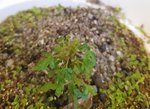Hey, everyone.
Thanks a lot for your feedback, I have learnt a lot from all of your answers.
Please excuse my late reply.
For what it´s worth, the little beast (as
AlainK calls it) continued growing, and it now has some 4-5 pairs of new leaves. They have the same the growth pattern so you really can´t tell it has grown at all. It is a very, very little beast.
Here is a picture for the curious:

Time will tell. Just keep it alive and healthy.
Thanks, I will do my best. I will make sure to put it in some Penumbra, although, for the moment, with a light cover it quite stands the intense morning and middleday sun we are having these days in Madrid.
Genetic variations or mutations are very possible. But usually those mutations are temporary; for a couple nodes and after that it's back to the usual.
If it stays dwarfed and stunted, then you might be the owner of an interesting cultivar.
I do however have to note that environmental factors can play a huge role in seedling phenotypes (the way they look as a sum of environmental factors and genotype) within the same genotype (the way they're programmed in their DNA). I have cloned a truckload of plants, and to be honest, maybe a couple hundred out of the 0.5 million were exactly the same. The older they got, the more the similarities became obvious.
In general, I would expect most variations in genetics to "smooth out" in six years. That's how long it takes in my garden for epigenetic changes (changes in the DNA expression due to environmental responses) to revert back to normal. If it still looks like this in 6 years, you can fairly assume that it's a genotypical/hardcoded variation.
For the moment the growth pattern has not changed. We will see if at some point it goes back to the ordinary, I will keep you updated.
Thank you for your answer! That temporal indication is very useful. I wonder what is the reason behind being 6 years the time when they smooth out, seems very interesting to me. Is those 6 years a valid time frame for every species in your garden that you have seen their epigenetic changes smoothed out? Or are some faster and some slower?
For what I have observed, nothing leds me to believe this is due to enviromental factors (phenotype) and not to genetics (genotype). Specially, due to the fact that seedlings are the fruit of sexual reproduction which is a source of genetic change, and that this seedling was in the same spot as several hundreds others. I could not appreciate, nor can I think of, something affecting this seedling and not any of the others, being so close one to each other. I guess some insect or bacteria or fungus could have easily affected it, but then, why not any more of the others?
Do you have, or are there other Acer palmatum cultivars in your neighbourhood ?
A. p. often hybridize, maybe that's why. Anyway, that the kind of find maple fans like me love to find, take good care of the little beast.

Oh, absolutely, you are right. I was very obtuse of me to not think of that. I have not seen many JM in the neighborhood, I know of 2 of them at a cross-pollination distance, but I am sure there are plenty more of them. Thanks again, I will do my best.
Cross pollination is also likely to introduce new genes. You know who the mother is but only the bees know the father and they never give away secrets.
I have selected similar seedlings for dwarf traits. Some continue to grow this way, some grow out of it as they get larger and look normal. A couple now alternate between really close nodes and longer more normal growth. After pruning those ones revert to the really close nodes for a season or 2 then start to produce long shoots again. They seem to be difficult to shape and frustrating for bonsai.
Definitely grow this one separately. It may be great for bonsai. It may prove really difficult. It might have really attractive traits as a landscape tree and you will make a fortune on the royalties after you patent the variety. It may have no special features and no-one will be interested. As already stated, only time will tell.
Thank you. Yes, I realize that when treating with tree species one needs a lot of time and patience before knowing what is really happening with a seedling. But I am learning a lot with all your answers, that alternation of close and long nodes seems really peculiar. Do you have any tips to keep it alive and healthy? I have no experience with JM of dwarf cultivars or with dwarf traits. Thanks again.
I already have it separately and I will keep close watch to see how it comes forward.








